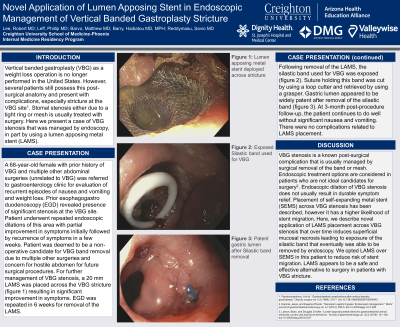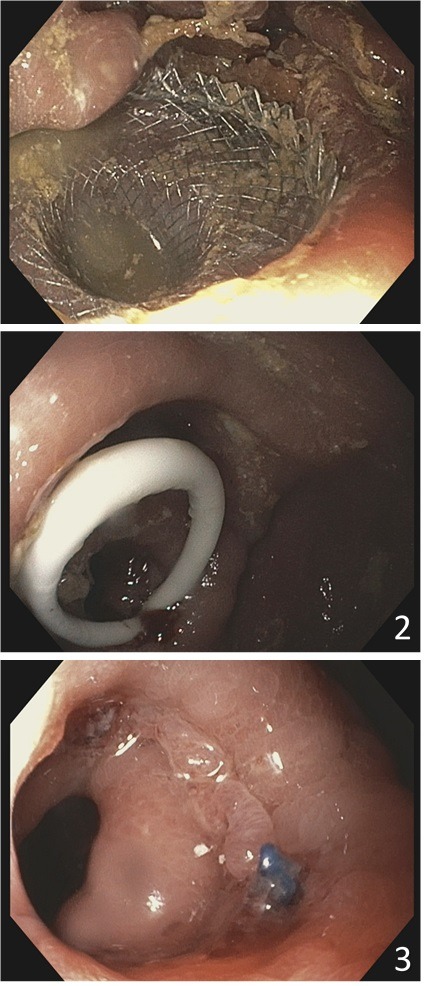Monday Poster Session
Category: Interventional Endoscopy
P2312 - Novel Application of Lumen Apposing Stent in Endoscopic Management of Vertical Banded Gastroplasty Stricture
Monday, October 23, 2023
10:30 AM - 4:15 PM PT
Location: Exhibit Hall

Has Audio
- RL
Robert Lee, MD
Creighton University
Phoenix, Arizona
Presenting Author(s)
Robert Lee, MD, Phillip Leff, DO, Matthew M. Barvo, MD, Hadiatou Barry, MD, MPH, Savio Reddymasu, MD
Creighton University, Phoenix, AZ
Introduction: Vertical banded gastroplasty (VBG) is a weight loss surgery that is no longer performed in the United States. However, several patients are affected today due to this post-surgical anatomy and present with multiple complications, especially stricture at the VBG site. Stomal stenosis secondary to a tight ring or mesh is typically treated through surgery. Here, we present a case of VBG stenosis managed endoscopically, in part with the use of a lumen apposing metal stent (LAMS).
Case Description/Methods: A 68-year-old female with history of VBG with multiple other unrelated abdominal surgeries was referred to Gastroenterology clinic for evaluation of recurrent episodes of nausea with postprandial vomiting and weight loss. Prior esophagogastroduodenoscopy (EGD) revealed presence of significant stenosis at the VBG site. The patient underwent repeated endoscopic dilations for this area with only partial improvement initially, followed by recurrence of symptoms within a few weeks. She was deemed a non-operative candidate due to other multiple surgeries and concern for hostile abdomen for future surgical interventions. Further management for VBG stenosis involved a 20 mm LAMS being placed across the stricture (Fig 1) resulting in significant symptomatic improvement. EGD was repeated after 6 weeks for LAMS removal. After removal, a white Silastic band from the VBG was exposed (Fig 2). The suture for this band was cut using a loop cutter and retrieved using a grasper. Gastric lumen looked to be widely patent after Silastic band removal. At 3-month post-procedure follow-up, the patient continues to do well without significant nausea or vomiting. There were no complications related to LAMS placement.
Discussion: VBG stenosis is a known post-surgical complication that is usually managed by surgical removal of the band or mesh. Endoscopic treatment options are considered in non-ideal surgical candidates. Endoscopic dilations of VBG stenosis do not typically result in durable symptom alleviation. Placement of self-expanding metal stents (SEMS) across VBG stricture has been described, but there is a higher likelihood of stent migration. Here, we describe a novel application of LAMS placement to gradually induce superficial mucosal necrosis leading to exposure of the Silastic band that can later be removed endoscopically. LAMS was chosen over SEMS in this patient to reduce risk of stent migration. LAMS appears to be a safe and effective alternative to surgery in patients with VBG stricture.

Disclosures:
Robert Lee, MD, Phillip Leff, DO, Matthew M. Barvo, MD, Hadiatou Barry, MD, MPH, Savio Reddymasu, MD. P2312 - Novel Application of Lumen Apposing Stent in Endoscopic Management of Vertical Banded Gastroplasty Stricture, ACG 2023 Annual Scientific Meeting Abstracts. Vancouver, BC, Canada: American College of Gastroenterology.
Creighton University, Phoenix, AZ
Introduction: Vertical banded gastroplasty (VBG) is a weight loss surgery that is no longer performed in the United States. However, several patients are affected today due to this post-surgical anatomy and present with multiple complications, especially stricture at the VBG site. Stomal stenosis secondary to a tight ring or mesh is typically treated through surgery. Here, we present a case of VBG stenosis managed endoscopically, in part with the use of a lumen apposing metal stent (LAMS).
Case Description/Methods: A 68-year-old female with history of VBG with multiple other unrelated abdominal surgeries was referred to Gastroenterology clinic for evaluation of recurrent episodes of nausea with postprandial vomiting and weight loss. Prior esophagogastroduodenoscopy (EGD) revealed presence of significant stenosis at the VBG site. The patient underwent repeated endoscopic dilations for this area with only partial improvement initially, followed by recurrence of symptoms within a few weeks. She was deemed a non-operative candidate due to other multiple surgeries and concern for hostile abdomen for future surgical interventions. Further management for VBG stenosis involved a 20 mm LAMS being placed across the stricture (Fig 1) resulting in significant symptomatic improvement. EGD was repeated after 6 weeks for LAMS removal. After removal, a white Silastic band from the VBG was exposed (Fig 2). The suture for this band was cut using a loop cutter and retrieved using a grasper. Gastric lumen looked to be widely patent after Silastic band removal. At 3-month post-procedure follow-up, the patient continues to do well without significant nausea or vomiting. There were no complications related to LAMS placement.
Discussion: VBG stenosis is a known post-surgical complication that is usually managed by surgical removal of the band or mesh. Endoscopic treatment options are considered in non-ideal surgical candidates. Endoscopic dilations of VBG stenosis do not typically result in durable symptom alleviation. Placement of self-expanding metal stents (SEMS) across VBG stricture has been described, but there is a higher likelihood of stent migration. Here, we describe a novel application of LAMS placement to gradually induce superficial mucosal necrosis leading to exposure of the Silastic band that can later be removed endoscopically. LAMS was chosen over SEMS in this patient to reduce risk of stent migration. LAMS appears to be a safe and effective alternative to surgery in patients with VBG stricture.

Figure: Fig 1: Lumen apposing metal stent deployed across stricture
Fig 2: Exposed Silastic band used for VBG
Fig 3: Patent gastric lumen after Silastic band removal
Fig 2: Exposed Silastic band used for VBG
Fig 3: Patent gastric lumen after Silastic band removal
Disclosures:
Robert Lee indicated no relevant financial relationships.
Phillip Leff indicated no relevant financial relationships.
Matthew Barvo indicated no relevant financial relationships.
Hadiatou Barry indicated no relevant financial relationships.
Savio Reddymasu indicated no relevant financial relationships.
Robert Lee, MD, Phillip Leff, DO, Matthew M. Barvo, MD, Hadiatou Barry, MD, MPH, Savio Reddymasu, MD. P2312 - Novel Application of Lumen Apposing Stent in Endoscopic Management of Vertical Banded Gastroplasty Stricture, ACG 2023 Annual Scientific Meeting Abstracts. Vancouver, BC, Canada: American College of Gastroenterology.
